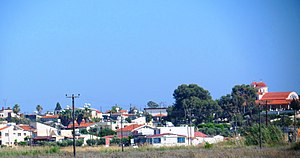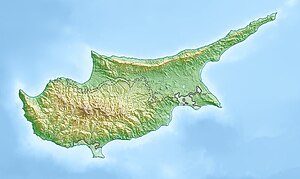Akrotiri (village): Difference between revisions
m Reverted edits by 119.47.109.222 (talk) to last version by Chipmunkdavis |
No edit summary |
||
| Line 24: | Line 24: | ||
<!-- Location ------------------> |
<!-- Location ------------------> |
||
|subdivision_type = Country |
|subdivision_type = Country |
||
|subdivision_name = {{flag|United Kingdom}} |
|subdivision_name = {{flag|Cyprus}} <br>{{flag|United Kingdom}} |
||
|subdivision_type1 = [[British Overseas Territory]] |
|subdivision_type1 = [[British Overseas Territory]] |
||
|subdivision_name1 = [[Akrotiri and Dhekelia]] |
|subdivision_name1 = [[Akrotiri and Dhekelia]] |
||
Revision as of 09:18, 16 June 2022
Akrotiri
Ακρωτήρι Ağrotur | |
|---|---|
village | |
 | |
| Coordinates: 34°36′3″N 32°57′18″E / 34.60083°N 32.95500°E | |
| Country | |
| British Overseas Territory | Akrotiri and Dhekelia |
| Population (2001)[1] | |
| • Total | 684 |
| Time zone | UTC+2 (EET) |
| • Summer (DST) | UTC+3 (EEST) |
Akrotiri (Greek: Ακρωτήρι, literally Cape, Template:Lang-tr) is a village within the Akrotiri Sovereign Base Area, which forms part of the British Overseas Territory of Akrotiri and Dhekelia. It is the only village in the Western SBA with a significant non-military population.
The village contains two small churches dedicated to St. Cross and St. George. To the south is a site called Kourion (Greek: Κούριον) containing the ruins of an ancient settlement.[2] Of the place Stefano Lusignan in his Description de toute l'isle de Cypre (Paris, 1580) says: "Cury est une ville antique, située au milieu du Promontoire des chats."[3] ("Kouria is an ancient town situated in the middle of the Headland of Cats.")
Holy Monastery of St Nicholas of the Cats
Two kilometres east of the village—in the middle of fields and orchards—is the ancient monastery of Saint Nicholas of the Cats (Άγιος Νικόλαος των Γατών).
Early history
The monastery is mentioned by travellers in the fifteenth century, but the fullest account is given by Felix Fabri, a Dominican who visited Cyprus in 1480 and 1483. He mentions Saint Nicholas as an isolated monastery "surrounded by serpents" where the monks kept cats to protect themselves.[4] Writing about a century later in the sixteenth century, Stefano Lusignan reports a tradition that associated the first establishment of this monastery to Saint Helena who, on her visit to Cyprus, found it infested with poisonous snakes. Hundreds of cats from Egypt or Palestine were imported to the place where her ship had landed, the Akrotiri peninsula. Kalokeros, then appointed as governor, is said to have founded the monastery and the cats attached themselves to the establishment thereafter.[5]
Architectural remains

Parts of the current church date to the Lusignan period, notably the door with a moulded arch on the north side of building. The marble lintel is carved with a cross in the centre and two shields on each side. One has a rampant lion of the usual Lusignan variety, while the others are probably personal and episcopal in nature.[6] Since the restoration and repair of the church, a contemporary mosaic of Saint Nicholas has been inserted in the tympanum above the lintel, and a portico added across the entire north side of the church.
After the establishment of Ottoman rule, Jacques de Villamont, who visited in 1588, reported the abbey remained almost whole, "having received no injury from the Turks when they took Cyprus from the Venetians in 1570." However, "the cats are dead from want of food but their memory lives in the name Capo delle Gatte."[7] The traveller, humanist and writer Kryštof Harant provided a charming woodcut of the cats and snakes amidst the monastic buildings in his 1608 book Journey from Bohemia to the Holy Land, by way of Venice and the Sea, while de Beauvau, writing in the same period, reported that cats were gone, but that some monks were still resident.[8] The monastery seems to have fallen slowly to ruins over the course of the seventeenth century so that the eighteenth, the Metropolitan Bishop Makarios I undertook its restoration. The church as it presently stands probably reflects his work. His attempts to revive the monastery faltered and the management of the monastery was assumed by the Bishopric of Kiti to which the property belonged. Writing in 1918, George H. Everett Jeffery says: "At the present day the monastery ... is a ruin of which only the church and one arcade of the cloister survive in a condition to show the original design."[9] The arcade he mentions is probably that which survived to the 1970s and is now incorporated into the restored cloister.
Recent history
In 1960, the church of the monastery was repaired, while shortly after 1974 an elderly monk from the Monastery of Apostle Barnabas initiated efforts to revive the Monastery. He died before finishing his work but from 1983, two nuns from Agios Georgios Alamanos resumed the effort. Emulating St. Helena, they decided to keep 100 cats in the monastery. In 1991, on the name day of Agios Nicolaos nun Kassiani was declared abbess. Today, the nunnery is administered by the Bishopric of Lemesos.[10]
Literary responses
The Nobel laureate Giorgos Seferis wrote a poem about Saint Nicholas of the Cats in 1969, translated into English in 1995.[11] An article by Benjamin Arbel also reflects on the cats and their significance in Renaissance writing.[12]
Gallery
-
Saint Nicholas of the Cats, church from the NW as it stood in 1973
-
Saint Nicholas of the Cats, door of the church as it stood in 1973
-
Saint Nicholas of the Cats, arcade of the cloister as it stood in 1973
-
Saint Nicholas of the Cats, cloister, 2017
-
Saint Nicholas of the Cats, gate, 2017
References
- ^ Census 2001
- ^ George H. Everett Jeffery, A Description of the Historic Monuments of Cyprus.: Studies in the Archaeology and Architecture of the Island (London: Zeno, 1983): 373.
- ^ Heritage Gazetteer of Cyprus, see: http://www.cyprusgazetteer.org/hu/442/1118/ Retrieved June 2016.
- ^ Nicolaou-Konnari, Angel, and Christopher Schabel. Lemesos: A History of Limassol in Cyprus from Antiquity to the Ottoman Conquest (Newcastle upon Tyne : Cambridge Scholars Publishing, 2015)
- ^ George H. Everett Jeffery, A Description of the Historic Monuments of Cyprus.: Studies in the Archaeology and Architecture of the Island (London: Zeno, 1983): 371.
- ^ George H. Everett Jeffery, A Description of the Historic Monuments of Cyprus.: Studies in the Archaeology and Architecture of the Island (London: Zeno, 1983): 373.
- ^ Jacques de Villamont, Les Voyages du Seigneur [Jacques] de Villamont (Paris: De Monstr'oeil & Richer, 1598). Text available online: http://gallica.bnf.fr/ark:/12148/bpt6k106196h/f1.image
- ^ Henry de Beauvau, Relation journalière du voyage du Levant faict & descrit par haut et puissant seigneur Henry de Beauvau baron du dict lieu et de Manonville seigneur de Fleville, Sermaise, Domepure, &c. Reveu augmenté et enrichy par lautheur de pourtraicts des lieux les plus remarquables (Paris, 1619), see http://gallica.bnf.fr/ark:/12148/btv1b8612079t/f102.image
- ^ George H. Everett Jeffery, A Description of the Historic Monuments of Cyprus.: Studies in the Archaeology and Architecture of the Island (London: Zeno, 1983): 372.
- ^ The recent history is given here: http://akrotiri.org.cy/en/what-to-know-ten/religious-life-ten/monastery-agios-nikolaos-cats-ten Archived 2020-11-27 at the Wayback Machine Retrieved June 2016
- ^ George Seferis: Collected Poems, translated, edited, and introduced by Edmund Keeley and Philip Sherrard (Princeton: University Press, 1995.
- ^ Benjamin Arbel, "Cypriot Wildlife in Renaissance Writings," in Cyprus and the Renaissance (1450-1650), ed. Benjamin Arbel, Evelien Chayes, and Harald Hendrix (Turnhout: Brepols, 2012).







